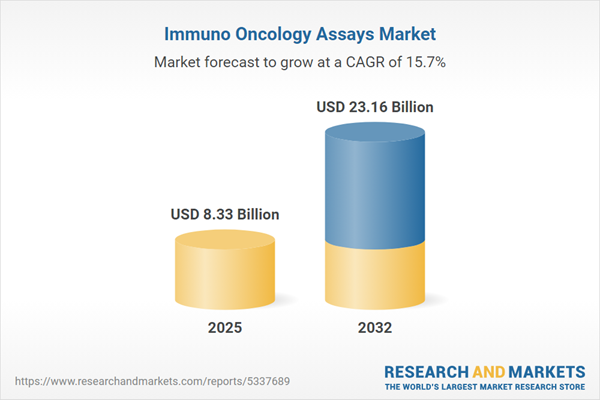Speak directly to the analyst to clarify any post sales queries you may have.
The immuno oncology assays market is evolving rapidly, shaped by new technologies and regulatory complexity. Senior leaders seeking actionable insight need a clear view into the drivers, risks, and opportunities that define this dynamic global sector.
Market Snapshot: Immuno Oncology Assays Market Growth and Outlook
The immuno oncology assays market expanded from USD 7.21 billion in 2024 to USD 8.33 billion in 2025. Projected to maintain a robust CAGR of 15.69%, the market is forecasted to reach USD 23.16 billion by 2032. Market momentum is shaped by substantial investments in cancer research, the adoption of advanced analytical platforms, and growing emphasis on personalized cancer therapies. Growth is distributed across geographic regions, technologies, and end-user segments, each influenced by unique regulatory climates and healthcare priorities.
Scope & Segmentation Overview
This detailed report provides comprehensive coverage and precise segmentation to support strategic planning. The following key categories highlight the breadth and depth of analysis:
- Technology Types: Flow cytometry, mass cytometry, immunoassays (ELISA and multiplex immunoassay), next generation sequencing (targeted panel, whole exome and whole genome sequencing)
- Product Categories: Consumables (probes, antibodies, reagents, kits), and instruments (automated systems, platform-based instruments)
- Sample Types: Blood, cell lines, tissue
- End User Segments: Academic and research institutes, universities, diagnostic laboratories, hospitals and clinics, pharmaceutical and biotechnology companies
- Indications: Breast cancer, hematologic cancers, lung cancer, melanoma
- Applications: Biomarker discovery, companion diagnostics, cytokine analysis, immune monitoring, tumor microenvironment analysis
- Regional Coverage: Americas (including North America, Latin America), Europe, Middle East and Africa, Asia-Pacific
- Company Analysis: Thermo Fisher Scientific Inc., Danaher Corporation, Merck KGaA, Agilent Technologies, Reaction Biology Corporation, Bio-Rad Laboratories, Creative Biolabs, QIAGEN N.V., Illumina Inc., Becton, Dickinson and Company
Primary Keyword: Immuno Oncology Assays Market
Key Takeaways for Senior Decision-Makers
- Rapid advancements in flow cytometry, mass cytometry, and high-throughput immunoassay platforms are transforming research and clinical workflows.
- Technology integration—especially coupling next generation sequencing and artificial intelligence—enables deeper insights into immune response and biomarker discovery.
- Regional variations demand customized market entry and growth strategies, particularly in markets with divergent regulatory frameworks and infrastructure capabilities.
- Collaborations between academic, clinical, and industrial partners are critical for accelerating assay development, streamlining clinical trials, and commercializing innovative solutions.
- Stakeholders must closely monitor evolving end-user needs, from personalized medicine to immune monitoring, to position portfolios for future demand.
- Laboratory efficiency and data quality are increasingly dependent on standardized assay protocols, automated platforms, and robust supply chain management.
2025 U.S. Tariff Impact on Supply Chains and Cost Structures
The introduction of new tariff measures in the United States from 2025 presents unique challenges affecting costs, procurement, and inventory across global supply chains. Increased duties on imported components such as reagents, antibodies, and precision instruments may drive organizations to reassess sourcing strategies, negotiate domestic manufacturing partnerships, and tighten risk management protocols. End users and manufacturers alike will need to optimize vendor portfolios, streamline logistics, and mitigate potential delays or quality concerns resulting from these changes.
Methodology & Data Sources
This report is built on a multi-phase research approach integrating extensive secondary research with in-depth interviews and quantitative surveys. All insights were validated through data triangulation and peer review by industry experts to ensure analytical accuracy, reliability, and practical relevance for strategic decision-making.
Why This Report Matters
- Offers actionable intelligence to strengthen product development, channel strategies, and market positioning within a dynamic regulatory environment.
- Enables proactive risk mitigation and resource optimization amid global economic uncertainty and evolving supply chain constraints.
- Equips executive leadership with data-driven guidance tailored for diverse stakeholder priorities, from R&D to commercialization and beyond.
Conclusion
Strategic agility, operational resilience, and technological foresight are vital for sustained growth in immuno oncology assays. This analysis supports informed strategic decisions by highlighting key market dynamics and innovation pathways.
Additional Product Information:
- Purchase of this report includes 1 year online access with quarterly updates.
- This report can be updated on request. Please contact our Customer Experience team using the Ask a Question widget on our website.
Table of Contents
3. Executive Summary
4. Market Overview
7. Cumulative Impact of Artificial Intelligence 2025
Companies Mentioned
The companies profiled in this Immuno Oncology Assays market report include:- Thermo Fisher Scientific Inc.
- Danaher Corporation
- Merck KGaA
- Agilent Technologies, Inc.
- Reaction Biology Corporation
- Bio-Rad Laboratories, Inc.
- Creative Biolabs
- QIAGEN N.V.
- Illumina, Inc.
- Becton, Dickinson and Company
Table Information
| Report Attribute | Details |
|---|---|
| No. of Pages | 198 |
| Published | October 2025 |
| Forecast Period | 2025 - 2032 |
| Estimated Market Value ( USD | $ 8.33 Billion |
| Forecasted Market Value ( USD | $ 23.16 Billion |
| Compound Annual Growth Rate | 15.6% |
| Regions Covered | Global |
| No. of Companies Mentioned | 11 |









